Understanding Edible Mushrooms: A Comprehensive Guide
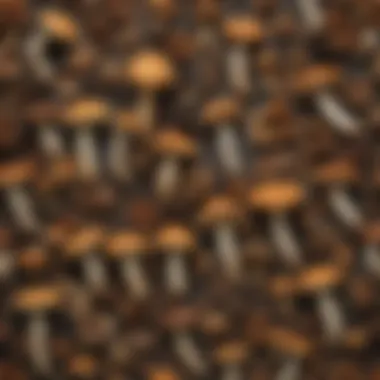
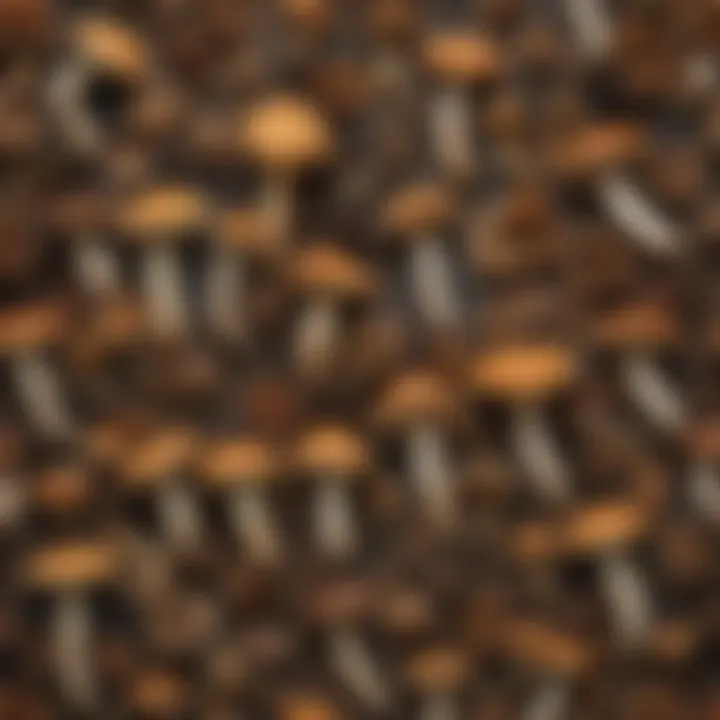
Intro
Edible mushrooms are a fascinating subject of exploration, drawing in culinary enthusiasts and nature lovers alike. These fungi are not only a delicious addition to many dishes but also present a complex world of identification, health considerations, and preparation techniques. Knowing which mushrooms are safe to consume is essential, as the stakes can be quite high; some mushrooms are toxic and can lead to serious health issues. Therefore, acquiring the knowledge to distinguish between edible and poisonous varieties is crucial for any forager.
This guide aims to provide a comprehensive look at edible mushrooms, focusing on methods of safe identification, the various types of mushrooms available, and the health risks associated with misidentification. It promotes a thoughtful approach to mushroom foraging and the enjoyment of these diverse organisms.
The journey into the world of edible mushrooms is both rewarding and potentially perilous. Proper education and a cautious mindset are keys to navigating this delicious yet intricate landscape. As we delve into the details, we hope to equip you with the confidence and skills necessary to explore and enjoy the realm of edible fungi.
Intro to Mushroom Identification
Mushroom identification is more than simply recognizing a mushroom by its visual appearance. It plays a crucial role in ensuring the safety of those who enjoy foraging and consuming mushrooms. The ability to distinguish between edible and toxic varieties can prevent potential health risks associated with misidentification. This section explores the significance of proper identification techniques, emphasizing the need for careful observation and informed decision-making while foraging.
The Importance of Knowing Edible from Toxic
Accurate knowledge of edible mushrooms versus toxic ones is vital for anyone interested in collecting wild fungi. Many mushrooms have look-alikes that are harmful or even deadly. For example, the deadly Amanita phalloides, often referred to as the "death cap," closely resembles the edible Agaricus bisporus, or button mushroom. This similarity makes precise identification crucial, as errors can lead to serious health consequences.
Wisely identifying mushrooms not only enhances the foraging experience but also encourages a deeper understanding of nature. Utilizing field guides and practical identification techniques further enriches this knowledge. An informed forager can confidently enjoy a wide range of safe edible mushrooms while respecting the ecosystem around them.
Common Myths About Mushrooms
There are several myths surrounding mushrooms that can mislead potential foragers. One common misconception is that all wild mushrooms are safe to eat unless proven otherwise. This belief is dangerous, as many edible varieties have toxic look-alikes. It is essential to approach wild mushroom foraging with a mindset based on education and caution.
Another myth suggests that eating mushrooms that animals consume is safe for humans. While some animals may have a tolerance for certain toxic mushrooms, humans do not possess the same immunity and can suffer severe reactions. Therefore, it is imperative to rely on accurate identification rather than anecdotal evidence.
Lastly, some individuals believe cooking mushrooms can eliminate toxins. While certain toxins are heat-sensitive, this is not true for all varieties. The only surefire way to avoid toxicity is through proper identification and knowledge of each species.
"Understanding what you are foraging is the key to safe and enjoyable experiences in the world of mushrooms."
In summary, being well-informed about mushroom identification helps in avoiding dangerous mistakes and enhances the foraging experience. Engaging with reliable resources and communities further aids in dispelling myths, making the journey into edible mushrooms both safe and educational.
Basic Characteristics of Edible Mushrooms
Understanding the basic characteristics of edible mushrooms is crucial for anyone interested in foraging. This section highlights the physical features and growth habitats that help in distinguishing edible types from their toxic counterparts. Paying attention to these characteristics can enhance one’s confidence in identification and ultimately contribute to safer foraging experiences.
Physical Features to Observe
Color
Color is one of the most noticeable factors when identifying mushrooms. The hue can vary widely among species, ranging from vibrant reds to subtle browns and whites. Key characteristics of color include variations based on species and maturity. For example, the cap of a Chanterelle typically has a bright yellow to orange tone, making it easily identifiable.
One unique feature of color is that some edible mushrooms may have color changes as they mature. This change can sometimes lead to confusion with toxic varieties. Therefore, understanding the specific color patterns associated with each mushroom type can provide significant benefits during identification tasks.
Shape
Shape refers to the overall form of the mushroom. Characteristics such as a conical, umbrella-like, or bulbous cap help determine the type. Edible mushrooms like the Porcini have a rounded cap, which is a beneficial trait for easy identification. The unique profiles of various fungi can lead to mistaken identity, especially with those mushrooms that have similar shapes but adverse properties.
Recognizing these shapes can guide foragers in making informed choices about what is safe to collect.
Size
The size of edible mushrooms varies significantly, which can affect their culinary potential. Some species may be small and dainty, while others are large and robust. The key characteristic related to size is that larger mushrooms, such as the Oyster mushroom, tend to be more noticeable and, thus, easier to gather.
One possible disadvantage of size is that smaller mushrooms may be overlooked, leading inexperienced foragers away from potentially safe options. Understanding size variation allows foragers to broaden their search effectively.
Growth Habitats
Forests
Forests represent a prime habitat for many edible mushroom species. The damp conditions and rich organic matter found in these areas create a favorable environment for growth. Key features include diverse ecosystems where mushrooms thrive under varying levels of shade and moisture.
One unique aspect of forests is the interdependence among species. Many edible varieties, like the Morel, are often found in specific forest settings, enhancing the chance of discovering them when foraging. However, the complexity of forest ecosystems can sometimes complicate identification efforts as similar-looking mushrooms may coexist.
Grasslands
Grasslands offer another distinct habitat for mushroom growth. Here, mushrooms can emerge from the soil in open, sunny spots. Key characteristics of grasslands include their typically dry conditions compared to forests. This means that some edible mushrooms, like the common Button mushroom, may be more abundant in these environments.
A unique feature of grasslands is the increased visibility of larger mushrooms, making them easier to spot during foraging. The simplicity of these habitats can aid in the identification process but may limit the variety compared to wooded areas.
Wooded Areas
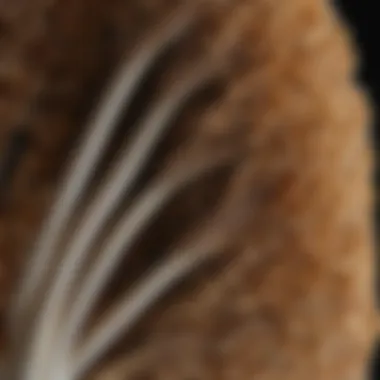
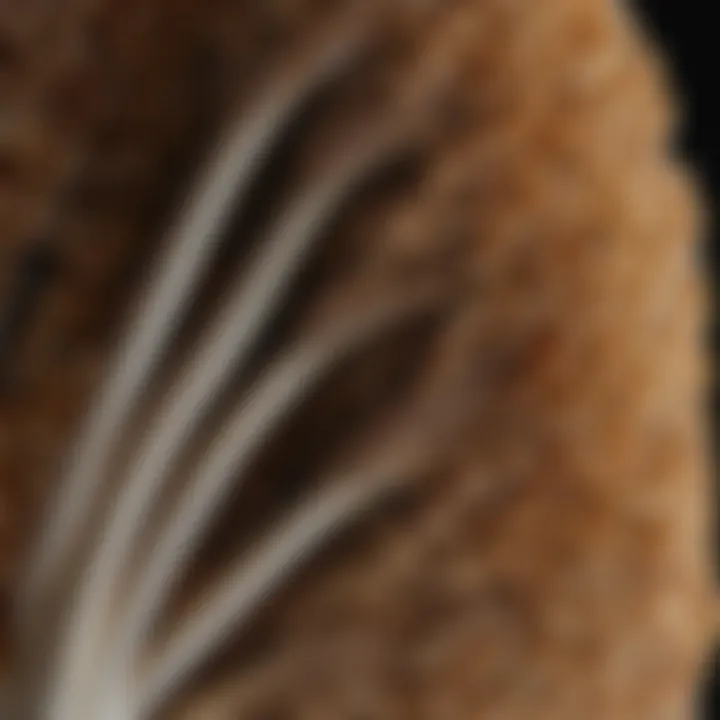
Wooded areas often contain a blend of characteristics found in both forests and grasslands. They can provide shelter and moisture, which helps various edible species thrive. One key benefit is the more extensive range of edible mushrooms available, from the sought-after Chanterelle to common field mushrooms.
However, the advantage comes with certain challenges, too. Encounters with toxic varieties that share similar growth conditions might occur, leading to misidentification. Foraging in wooded areas requires diligent observation and knowledge of which mushrooms are genuinely safe to consume.
In summary, understanding the basic characteristics of edible mushrooms is an essential aspect of foraging. By focusing on their physical features and preferred habitats, one can enhance their foraging experience while minimizing risks associated with misidentification.
Research and Study
Conducting thorough research and study is fundamental to mastering the identification of edible mushrooms. Understanding mushrooms requires more than just surface-level knowledge; it involves delving into their unique characteristics, habitats, and growth patterns. This knowledge not only enhances your foraging ability but also mitigates the risks associated with misidentification.
One significant benefit of research is the depth of information you gain about each species. Familiarizing yourself with the characteristics and common habitats of edible mushrooms allows you to make more informed decisions when exploring the outdoors. Practical skills developed through rigorous research can increase confidence in foraging.
When studying mushrooms, it is crucial to use reliable resources. Field guides, research papers, and online communities can serve as rich information sources. Engaging with this content allows for the formation of sound judgment, which is essential for distinguishing edible species from their toxic counterparts.
Field Guides and Identifying Resources
Field guides are indispensable tools for anyone interested in identifying edible mushrooms. They typically offer detailed descriptions of various mushroom species, highlighting distinguishing features such as color, shape, and size. Many guides are accompanied by images, which can significantly aid in visual identification. When selecting a field guide, look for ones that are well-reviewed and widely used, as these often provide accurate and comprehensive information. Bookmarks or notes in your field guides can serve as quick references while you forage, making it easier to cross-check your findings.
In addition to books, several websites and databases provide thorough compilations of edible mushrooms. Websites like Wikipedia and Britannica are valuable resources for understanding general categories of mushrooms.
Online Communities and Forums
Online communities and forums can greatly enrich your understanding of edible mushrooms. Platforms such as Reddit offer spaces for enthusiasts to share experiences, ask questions, and seek advice. Engaging with others who share your interests can provide insights that you may not find in traditional resources.
Joining forums allows you to learn from the experiences of seasoned foragers. Many communities host discussions about the latest mushroom foraging adventures, success stories, and identification pitfalls. Additionally, individuals in these online spaces often share photographs of their finds, further reinforcing learning through visual examples.
Communities may also highlight local events such as foraging walks, where members can learn hands-on under the guidance of more experienced foragers. Overall, the synergy of research, field guides, and online platforms creates a comprehensive approach to understanding edible mushrooms effectively.
Consulting Experts
Consulting experts in the field of edible mushrooms is an essential aspect of safe foraging. With the vast array of mushroom species, the importance of experienced guidance cannot be overstated. They offer invaluable insights, practical skills, and deeper understanding of mushroom identification. Engaging with experts ensures that foragers avoid costly mistakes that could lead to the consumption of toxic varieties.
Local Foraging Groups
Joining local foraging groups can significantly enrich the mushroom hunting experience. These groups often comprise individuals with varied levels of expertise, allowing beginners to learn from seasoned foragers. They organize outings, which provide hands-on experience in identifying edible mushrooms in their natural habitats.
- Networking Opportunities: Foraging is not just about collecting mushrooms; it is also about building community relationships. Local groups encourage sharing tips, experiences, and resources, creating an environment conducive to learning.
- Group Safety: Foraging with others is inherently safer. In the event of misidentification, other members can offer corrective advice, reducing the risk of toxicity.
- Access to Knowledge: Members often discuss their findings in weekly or monthly meetings. This collective knowledge can educate participants on seasonal changes in mushroom growth and local varieties.
Overall, local foraging groups have much to offer. As foraging becomes more popular, these networks are invaluable resources for both education and safety in the field.
Workshops and Classes
Workshops and classes focused on mushroom identification greatly enhance the understanding of edible fungi. Such educational programs cover a range of topics from basic identification skills to advanced foraging techniques. Here are some benefits of participating in these sessions:
- Structured Learning: Workshops often have a defined curriculum, making it easier for participants to absorb information effectively. Topics might include the anatomy of mushrooms, toxic species, and specifics on culinary uses.
- Expert Guidance: Instructors typically possess extensive knowledge and experience. Learning directly from them allows for immediate clarification of any confusion that may arise during practical sessions.
- Practical Experience: Many workshops include field trips, providing opportunities to apply learned concepts. This hands-on approach solidifies understanding.
Ultimately, investing time in workshops and classes is a proactive way to build confidence in identifying edible mushrooms. Such educational endeavors anchor the knowledge necessary to forage responsibly.
Practical Identification Techniques
Understanding the methods available for identifying edible mushrooms is crucial for anyone interested in foraging. Practical identification techniques serve as fundamental tools in discerning which fungi are safe to consume and which are best avoided. The practice builds confidence and enables one to assess mushrooms effectively. Misidentifying a mushroom can lead to dire health risks, and thus learning proper techniques is essential.
Examining Gills and Spores
Gills and spores are primary features used for mushroom identification. These parts can significantly differ between species. Observing the gills, which are thin, blade-like structures located under the mushroom cap, offers insight into the type of mushroom. Their color can vary; for example, the gills may be white, yellow, or even pink.
Inspecting the attachment of the gills to the stem can also provide valuable information. Some mushrooms have gills that are attached directly to the stem, while others have them free of the stem. The spacing between gills can further assist in identification. Closely spaced gills are often found on certain species compared to more widely spaced ones.
Spores, tiny reproductive cells, are another vital aspect. Collecting a spore print requires placing the cap on a piece of paper and waiting for the spores to fall. The color of the spore print adds another layer to identifying mushrooms. Common colors include white, brown, and black. This technique is especially useful for distinguishing edible from toxic varieties, as certain mushrooms may look similar but spawn different colors.
Smell and Texture Tests
Another practical technique in mushroom identification involves engaging with smell and texture. Many edible mushrooms have distinctive scents. For example, the unmistakable aroma of a morel can differentiate it from other fungi. However, relying solely on smell should be approached with caution. Some toxic mushrooms might also possess a strong odor.
Texture is equally essential. Gently touching or breaking the mushroom can reveal information about its surface. For instance, certain mushrooms may feel slippery, while others are dry or have a velvety finish. Knowing the texture can help narrow down the options faster. Additionally, examining how the flesh reacts when cut or bruised can indicate whether a mushroom is edible or not.
In summary, employing examination of gills and spores along with smell and texture tests can provide essential data in the identification of edible mushrooms. Practicing these techniques with attention promotes a deeper understanding of the mushroom world, aiding in safe and enjoyable foraging.
Common Edible Mushroom Species
The classification of edible mushrooms is a critical aspect of foraging. Understanding common edible species guarantees safety and enhances culinary experiences. Recognizing distinguishing features of these mushrooms can sharpen one's foraging skills. These mushrooms range in flavor, texture, and nutritional value. Knowing these mushrooms also helps in avoiding harmful alternatives.
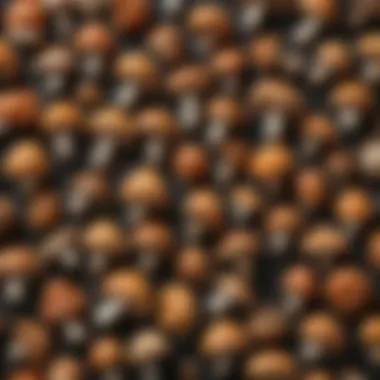

Button Mushrooms
Button mushrooms, scientifically known as Agaricus bisporus, are among the most familiar edible fungi worldwide. They have a mild flavor, making them versatile for various dishes. Available in multiple stages of maturity, button mushrooms can be found in several colors, including white and brown. Their popularity in cooking stems from their ability to absorb surrounding flavors well.
- Culinary Use: They can be used raw in salads or cooked in countless dishes, adding a delightful texture.
- Nutritional Benefits: These mushrooms are low in calories and are a good source of vitamins B and D.
They are generally easy to identify as they have a smooth cap and a rounded shape. It's essential, though, to ensure you do not confuse them with similar-looking but inedible varieties.
Chanterelles
Chanterelles, known formally as Cantharellus cibarius, are prized for their rich, peppery flavor. These mushrooms have a distinctive yellow-gold hue and a wavy, funnel-shaped cap. Searching for chanterelles often leads foragers to forested areas, particularly under oak and spruce trees. Their season usually occurs in late summer to early autumn.
- Culinary Use: Chanterelles add depth to sauces and are excellent in risottos or sautéed with butter.
- Nutritional Benefits: They are packed with vitamins A, C, and various minerals, contributing to overall health.
Identifying chanterelles involves careful observation. They lack true gills and have a unique branching structure underneath their caps. Avoiding toxic look-alikes requires practice and attention to detail.
Porcini
Porcini mushrooms, or Boletus edulis, are well-known in gourmet cooking. Their robust flavor and meaty texture make them stand out among other varieties. Porcini have a thick stem and a cap that ranges from light to dark brown. They thrive in moist environments, particularly in coniferous and broadleaf forests.
- Culinary Use: Often used dried, porcini mushrooms enhance the flavor of soups, sauces, and risottos.
- Nutritional Benefits: High in antioxidants, they support a healthy immune system and are rich in dietary fiber.
For accurate identification, observe their spongy undersides rather than gills. It is easy to mistake them for other bolete varieties, which may not be edible, hence careful inspection is essential.
Understanding these common edible mushroom species is key to safe foraging and culinary enrichment.
Exploring the world of edible mushrooms connects food lovers with nature and promotes healthier eating through whole, natural ingredients.
Toxic Mushroom Varieties to Avoid
Understanding which mushrooms to avoid is vital for anyone interested in foraging. Toxic mushrooms can cause severe health issues, including organ failure and death. By focusing on toxic mushroom varieties, this section aims to educate and protect foragers from potentially dire consequences. Knowledge about these mushrooms is essential to make informed choices.
Identifying Look-Alikes
Some edible mushrooms have toxic counterparts that may appear similar. Identifying these look-alikes is critical to safe foraging. For instance, the edible Chanterelles can be mistaken for the poisonous Jack-o'-lantern mushroom. Observing subtle differences can be a lifesaver.
Here are some tips to spot look-alikes:
- Color: Always check the color variations. Some toxic species may have similar shades.
- Gills: Many toxic mushrooms possess gills that are more prominent than their edible counterparts. Pay attention to the gill structure.
- Size and Shape: Dimensions and cap shapes can differ slightly. Note these variations.
- Location: Research the habitats; some mushrooms thrive only in specific environments.
Using a field guide or consulting experts can significantly reduce the risks associated with misidentification.
Misidentification is a common cause of mushroom poisoning. Always err on the side of caution.
Symptoms of Toxicity
Understanding the symptoms of mushroom poisoning is crucial if one accidentally consumes a toxic variety. Reactions can vary, depending on the type of mushroom and the amount ingested.
Common symptoms include:
- Nausea and Vomiting: Early signs often mimic food poisoning.
- Diarrhea: Loose stools can occur within hours post-consumption.
- Abdominal Pain: Discomfort can vary from mild to severe.
- Confusion or Hallucinations: Some mushrooms can affect mental state.
- Liver Damage: Severe cases may lead to liver issues, sometimes long after ingestion.
If toxicity is suspected, it is imperative to seek immediate medical attention. Knowing these symptoms can help mitigate dangers associated with toxic mushrooms.
By educating oneself about toxic varieties and their look-alikes, foragers can greatly reduce risks. Understanding the symptoms of toxicity completes the safety net one should have when venturing into the world of mushrooms.
Safety Precautions While Foraging
Mushroom foraging can be an exciting adventure, but it carries inherent risks. Understanding the importance of safety precautions is crucial for anyone interested in this activity. The world of mushrooms is vast, with many species that can look remarkably similar. Some edible varieties share traits with toxic mushrooms, making careful collection essential. This section aims to outline effective practices to ensure a safe foraging experience, discuss benefits, and highlight considerations when gathering wild mushrooms.
Best Practices for Collection
When foraging for edible mushrooms, following specific best practices can safeguard your health and that of others. Consider these guidelines:
- Educate Yourself: Familiarity with local edible species is vital. Use reliable field guides and take part in workshops or local foraging groups. Knowing the differences between species will help you safely identify edible types.
- Use a Basket: Always carry a breathable container, such as a wicker basket. Avoid plastic bags as they trap moisture, potentially spoiling the mushrooms.
- Harvest with Care: When collecting mushrooms, use a knife to cut them at the base. This helps preserve the surrounding mycelium, allowing for future growth. Be gentle to avoid damaging the environment.
- Label Your Finds: If you are in a group, label the mushrooms you collect. This way, if you have doubts about a type later, you can refer back to it or share with someone knowledgeable.
By adhering to these practices, you reduce the risk of misidentification and promote sustainable foraging.
Avoiding Harvesting Errors
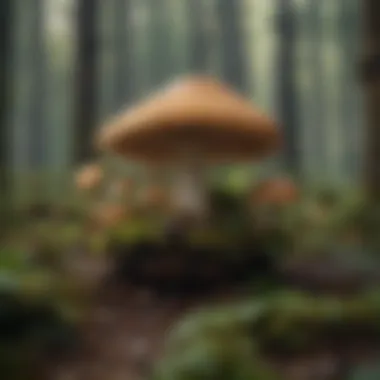
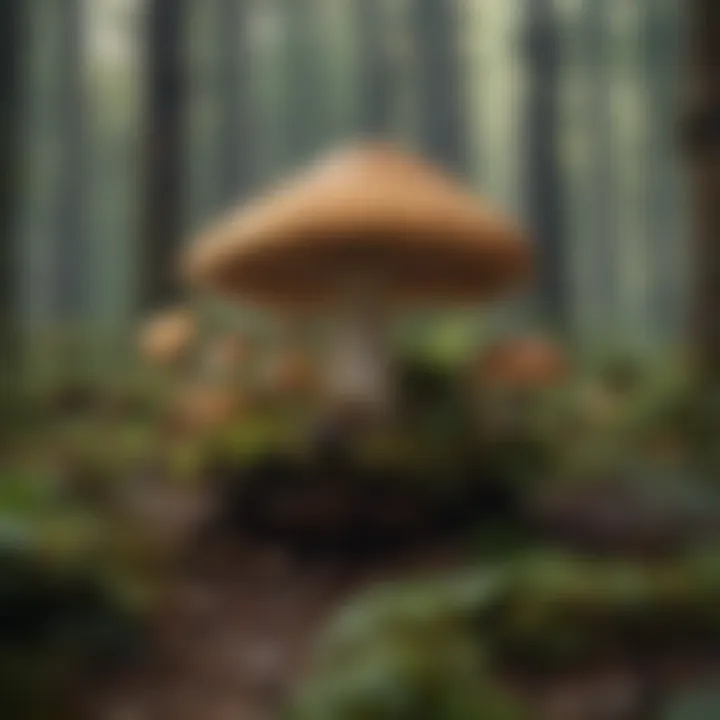
Harvesting errors can have serious consequences. Being aware of common pitfalls can keep you safe. Here are some key points to consider:
- Look-Alike Species: Many edible mushrooms have toxic look-alikes. For example, the chanterelle resembles the toxic Jack O'Lantern. Always compare visual features carefully before consuming.
- Environmental Factors: Mushrooms can absorb toxins from their surroundings, including heavy metals or pesticides. Be cautious about the area where you forage, avoiding spots near roads or contaminated sites.
- Timing: Mushroom season varies by region, so timing your foraging trip can significantly impact your success and safety. Late summer to early fall is often peak for many species.
- Sample Testing: If you are unsure about a mushroom, do not consume it. Even small amounts of a toxic mushroom can cause health issues. It is better to leave questionable samples behind.
"The distinction between edible and toxic mushrooms is often subtle. Only gather what you can positively identify."
By observing these recommendations, foragers can significantly mitigate risks. Ultimately, safety precautions while foraging enhance the experience, enabling enthusiasts to enjoy the bounty of nature without unnecessary concern.
Cooking and Preparing Edible Mushrooms
Cooking and preparing edible mushrooms is an essential step in enjoying their unique flavors and nutritional benefits. Proper preparation not only enhances the taste but also ensures safety and palatability. Different mushrooms offer various textures and tastes depending on how they are cooked. Understanding the best methods to clean and cook these fungi can elevate any dish.
Cleaning Techniques
When handling edible mushrooms, effective cleaning is crucial. Mushrooms can harbor dirt and debris which must be removed before cooking. A gentle approach is necessary to avoid damaging the delicate structure.
- Brushing: Use a soft-bristled brush or a dry cloth to remove surface dirt. This method prevents water absorption, which can make mushrooms soggy.
- Rinsing: If necessary, a quick rinse under cold running water can help. However, avoid prolonged soaking, as mushrooms absorb water quickly.
- Trimming: Remove any tough stems and blemished areas. This not only enhances the appearance but also boosts flavor.
Proper cleaning ensures that the natural flavors shine through in the final dish.
Cooking Methods
Various cooking methods can be employed to bring out the best flavors in edible mushrooms. Here are three popular techniques:
Sautéing
Sautéing is a quick cooking method that uses fat to cook food over relatively high heat. This is particularly beneficial for mushrooms, as it allows for caramelization, which enhances flavor. The key characteristic of sautéing is its speed and the ability to maintain a mushroom's texture.
Advantages:
- Retains moisture while allowing a crisp exterior.
- Versatile, as it can be flavored with herbs or spices during the cooking process.
Using this method, mushrooms like button or shiitake can become a delightful addition to stir-fries or as a topping.
Grilling
Grilling imparts a smoky flavor and creates a charred texture that is highly appealing. It is particularly effective for larger mushrooms such as portobello. One key aspect of grilling is the high heat, which helps to seal in moisture while creating a crust.
Advantages:
- Enhances flavor through caramelization and smoke.
- Ideal for outdoor cooking and gatherings.
Grilled mushrooms can serve as savory side dishes or as hearty fillings in sandwiches.
Roasting
Roasting requires even, dry heat and can intensify the mushroom's natural flavors. This method is typically performed in an oven at medium to high temperatures. The main characteristic of roasting is that it creates a rich, deep flavor profile.
Advantages:
- Allows for even cooking, producing tender mushrooms.
- Complements oven-roasted vegetables well.
Roasted mushrooms can be a superb addition to salads or served on their own with seasoning.
Proper cooking techniques ensure that edible mushrooms not only taste good but also showcase their full range of flavors and textures.
Culmination and Final Recommendations
The journey of understanding edible mushrooms is intricate and requires a serious commitment to accurate identification. In this guide, we covered various aspects of mushroom foraging, from recognizing edible species to ensuring safety during foraging. The final recommendations encapsulate the importance of safe practices, continued learning, and community involvement in this fascinating activity. By taking these steps, you not only enhance your mushroom knowledge but also contribute to a responsible foraging culture.
Recap of Safe Foraging Practices
Safe foraging starts with diligent research and mindful observation. Here are important points to remember:
- Know Your Mushrooms: Familiarize yourself with common edible species and their distinguishing features. This includes color, shape, and size.
- Use Resources Wisely: Field guides, local experts, and online communities are valuable assets. Ensure you have reliable resources before heading into the wild.
- Be Cautious: When in doubt about a mushroom's safety, do not consume it. Misplacing judgment can lead to serious health risks.
- Follow Local Guidelines: Understand regulations about foraging in your area. Respect nature and avoid overharvesting to maintain ecological balance.
"Mushroom foraging is not just about finding food. It is an experience that connects you to nature in profound ways."
By reflecting on these practices, foragers can enjoy the thrill of discovery while prioritizing safety.
Continued Learning and Community Involvement
Mushroom foraging is a continuous learning journey. Engaging in community activities can greatly enhance your understanding. Here are some ways to stay actively involved:
- Join Local Foraging Groups: Connect with like-minded individuals who share your passion. Group outings provide opportunities to learn from experienced foragers and exchange knowledge.
- Attend Workshops: Look for workshops or classes in your area. These events often include hands-on experiences, enhancing your identification skills and confidence.
- Participate in Online Forums: Platforms like reddit.com are filled with enthusiastic communities. You can ask questions, share experiences, and gain insights from seasoned foragers.
- Contribute to Local Conservation Efforts: Engage with organizations focused on habitat preservation and sustainable foraging practices. This helps ensure the health of mushroom populations for future generations.
In summary, the safe exploration of edible mushrooms requires a combination of knowledge, skills, and community support. By following these recommendations, you can make more informed decisions and safely enjoy the wonders of edible fungi.







